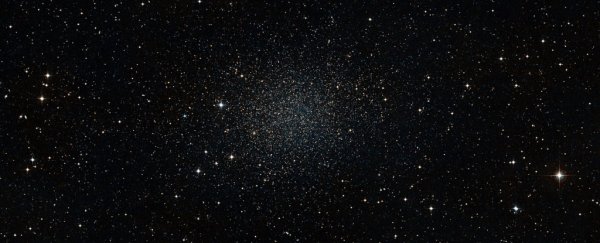Back when the Universe was young – around 13.7 billion years ago – the first stars formed in the soupy darkness, setting the cosmos alight.
We've yet to find any of these very first stars, known as Population III stars – but a star found in a dwarf galaxy orbiting the Milky Way may be the next best thing.
AS0039, located in the Sculptor dwarf spheroidal galaxy 290,000 light-years away, has a chemical composition suggesting it incorporates elements from a Pop III star that went hypernova.
According to an analysis led by astronomer Ása Skúladóttir of the University of Florence in Italy, it's not only the lowest metallicity star ever discovered outside of the Milky Way galaxy, it also has the lowest carbon abundance ever seen in any star.
If confirmed, AS0039 could be key to helping us understand how the Universe switched on its lights.
"We are in the presence of a secondary star with exceptional chemical characteristics: Low in iron, AS0039 is not even rich in carbon and has an extremely low amount of magnesium compared to other heavier elements, such as calcium," Skúladóttir explains in a press statement machine-translated from Italian.
Although astronomers have a pretty good understanding of how the Universe evolved from the Big Bang to its current scintillating state, the far reaches of space-time are difficult to peer into. For a few million years after the Big Bang, space was filled with a hot, murky, opaque gas. It wasn't until the first stars were born and their ultraviolet light ionized this gas that space began to clear, and light could stream freely.
Current-day star formation processes give us some idea about how these Pop III stars were born, but finding them, and their immediate traces, will be the best way to figure out how this strange period in the Universe's history really unfolded.
And that means stars that are very poor in heavy elements. Before stars formed, you see, there were no heavy elements in the Universe; it was a soup of mostly hydrogen and helium. When stars came along, they started to fuse nuclei in their cores to form heavier elements, all the way up to iron. Violently energetic events such as supernovae forged even heavier elements.
These elements, scattered throughout the Universe, were then taken up into subsequent generations of stars born from cosmic gas and dust. So, if we find stars that are relatively low in metals, that means the star must be quite old, from a time before metals were abundant.
AS0039 is very low in metals indeed. That in itself would be interesting. The Sculptor galaxy is quite metal-poor in general, with only 4 percent of the proportionate carbon abundance found in the Milky Way, suggesting it is quite primitive; AS0039 is metal-poor even for its location.
But Skúladóttir and her team found that the star is lacking in carbon and magnesium even more than usual for a metal-poor star. Since these elements are formed via stellar core fusion, this suggests an unusual origin for the cloud of molecular gas AS0039 formed from.
Such carbon-iron, magnesium-calcium and magnesium-titanium abundance ratios, the team said, are consistent with an extremely energetic explosion – a hypernova, 10 times more energetic than a supernova.
This is partly because calcium and titanium are explosive alpha-elements that form during a supernova explosion. During an even more energetic explosion, you get higher levels of calcium and titanium. This, the team said, could explain the abundances of elements in AS0039.
To figure out how it happened, they ran simulations. The best fit was the hypernova explosion of a Pop III progenitor star clocking in at roughly 21 times the mass of the Sun, with an energy of 10 x 1051 erg.
This would mean that AS0039 represents some of the first observational evidence for zero-metallicity hypernovae, and a spectacular opportunity to try and understand the very first stars in the Universe.
"The study shows that the analysis of stellar fossils allows us not only to indirectly determine the mass of the first stars," says astronomer Stefania Salvadori of the University of Florence, "but it also provides crucial information about the energy of the first supernova explosions. And therefore on the first steps of the Universe."
The research has been published in The Astrophysical Journal Letters.
